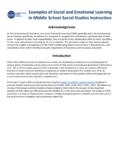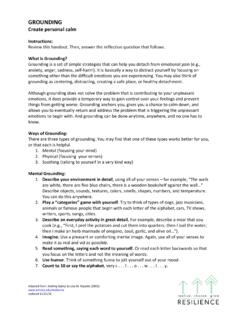Transcription of PT-PEAT Supplemental Materials 2017 draft - FSBPT
1 Supplemental Materials for the Physical Therapist Practice Examination and Assessment Tool PT PEAT for the Physical Therapist National Physical Therapy Examination Copyright 2017 by the Federation of State Boards of Physical Therapy All rights reserved. No part of this document may be reproduced in print, electronically, or in any other manner, or in any other manner, without the express written permission of the Federation of State Boards of Physical Therapy. Federation of State Boards of Physical Therapy 124 West Street South, 3rd Floor Alexandria, VA 22314 2825 Introduction The Federation of State Boards of Physical Therapy ( FSBPT ), which develops, maintains, and administers the Physical Therapist National Physical Therapy Examination (NPTE PT), is publishing this guide in response to requests for accurate, detailed information about the design and content of the Practice Examination & Assessment Tool (PEAT).
2 This guide has been developed specifically for you, the candidate for the NPTE PT. With the PEAT, you will be able to see questions that are from retired forms of the NPTE PT and other questions similar to those on the actual examination, along with the reasoning behind each question. You will also see the detailed structure of the examination and will receive advice on preparing for it. There are two major parts of the PEAT. The first part is this Supplemental material , which provides information on the examination and advice on how to use the Practice Examination in your review. The second part consists of the PEAT Examinations. The examinations will allow you to simulate the experience of taking the NPTE PT and will provide you with information to assist you in preparing for it.
3 THE PEAT Supplemental Materials Chapter 1 provides you with advice on studying for the NPTE PT. Chapter 2 continues on this theme with practical, specific advice on tasks to do before the examination day and how to answer questions once you are taking the examination. Chapter 3 presents a detailed description of the Test Content Outline that forms the foundation for the examination. This blueprint is crucial to understanding the range of content that appears on the examination. The chapter also gives advice on how to use the information from the Test Content Outline in your review process. Chapter 4 discusses how to use the Practice Examination in studying for the NPTE PT.
4 It describes the experience you will have in using the Practice Examination on the Internet. It also gives advice on how to analyze your responses to the sample questions. Finally, Chapter 5 lists the references cited in the Practice Examination questions. It is divided into two parts. The first part lists the most frequently cited references in PEAT. The second part lists all the references cited in PEAT in alphabetical order by author s last name. This should make it easier for you to identify additional content sources for your review. However, you should NOT treat this as a recommended list. There are many other texts that you can use as well that will contain similar information.
5 Further, the questions on the actual NPTE PT may use texts not listed here. Introduction THE PRACTICE EXAMINATIONS The Practice Examination is the heart of the PEAT process. The contents of this part of the guide are available only on the Internet. PEAT was designed to closely replicate the look and feel of the NPTE PT at the testing center. You will have access to two 250 item Practice Examination forms that will help you to assess your own level of content knowledge. One of the practice forms is from a retired NPTE PT form. The other practice form contains items written specifically for PEAT by experienced NPTE PT item writers. Using these examinations, you can reproduce on your computer the experience of taking the real NPTE PT.
6 You must complete the Practice Examination before you can proceed to the Study Mode of PEAT. We have done this intentionally so that you can get an accurate assessment of your current level of knowledge and identify specific content topics you may need to study. Once you complete the Practice Examination, you will have access to a PEAT Performance Feedback Report which will summarize your performance on PEAT. After you complete the examination, you will have access to Item Review Mode within PEAT. This consists of the same 250 questions. However, for each question, we have provided the correct answer, rationales explaining why the right answer is right and the wrong answers are wrong, and one or more references that deal with the topic and supports the item and its rationale.
7 Upon completion of the second PEAT form, you will, again, receive an enhanced score report and have access to Study Mode. FSBPT would appreciate receiving comments from users about this guide whether you found it helpful or have ideas on how it could be improved. Send your comments by mail, fax, or e mail, as follows: Mail comments to: Federation of State Boards of Physical Therapy PT PEAT 124 West Street South, 3rd Floor Alexandria, VA 22314 Fax comments to: 1 703 739 9421 E mail comments to: Introduction Table of Contents Introduction Chapter 1. Studying for the Examination .. 1 Chapter 2. Test Taking Strategies .. 3 Chapter 3. Using the Test Content Outline in Your Review.
8 7 Chapter 4. Using the Practice Examination in Your Review .. 24 Chapter 5. References .. 28 Chapter 1: Studying for the Examination 1 Chapter 1 Studying for the Examination PREMISE OF THE EXAMINATION Questions on the NPTE PT are written for entry level Physical Therapists and encompass the knowledge that candidates obtain during entry level education. You are not expected to have expertise in specialty areas when you take the examination, and the questions are not written with that intent. The questions are written to test your entry level knowledge of both the didactic coursework and the clinical experiences you were exposed to during your entry level training.
9 Therefore, keep in mind that the examination will have questions relating to both didactic coursework (theory) and clinical experiences (application). REVIEWING FOR THE EXAMINATION In reviewing for the NPTE PT, remember that the questions are written in a global fashion, , the questions are not from one curriculum or one textbook, and that the item writers are physical therapists from a variety of practice settings and geographical areas. Therefore, the terminology used may be slightly different from what you were exposed to in your specific course work. However, the terminology used is consistent with language commonly used in physical therapy textbooks. You should take the following into consideration as you plan your review: Didactic coursework.
10 Review those areas of your didactic work that you feel you have forgotten or that you did not utilize on your clinical experiences. Keep in mind that most of the examination questions will be application questions rather than memory recall questions. You will need to apply your knowledge rather than simply list or recall information. Clinical experiences. The application of knowledge through your clinical experiences cannot be overemphasized in reviewing for the NPTE PT. The majority of questions will require that you apply knowledge and utilize critical thinking skills to correctly answer the question. Candidates sometimes feel that the questions do not have one obvious answer.





